August von Mackensen
| August von Mackensen | |
|---|---|
 Field Marshal von Mackensen | |
| Nickname(s) | The Last Hussar |
| Born |
6 December 1849 Haus Leipnitz, Province of Saxony, Prussia |
| Died |
8 November 1945 (aged 95) Habighorst, Province of Hanover, Allied-occupied Germany[1] |
| Allegiance |
|
| Service/branch |
|
| Years of service | 1869–1920 |
| Rank | Generalfeldmarschall |
| Commands held | Army Group Mackensen |
| Battles/wars |
Franco-Prussian War World War I |
| Awards |
Grand Cross of the Iron Cross Pour le Mérite with Oak Leaves Order of the Black Eagle |
| Relations | Eberhard von Mackensen |
| Signature |
|
Anton Ludwig August von Mackensen (6 December 1849 – 8 November 1945), born August Mackensen, was a German field marshal.[2] He commanded with success during the First World War and became one of the German Empire's most prominent military leaders. After the Armistice, Mackensen was interned for a year. He retired from the army in 1920 and was made a Prussian state councillor in 1933 by Hermann Göring. During the Nazi era, Mackensen remained a committed monarchist and sometimes appeared at official functions in his First World War uniform. He was suspected of disloyalty to the Third Reich, although nothing was proven against him.
Early years
Mackensen was born in Haus Leipnitz, near the village of Dahlenberg (today part of Trossin) in the Prussian Province of Saxony, to Louis and Marie Louise Mackensen. His father, an administrator of agricultural enterprises, sent him to a Realgymnasium in Halle in 1865, seemingly in the hope that his eldest son would follow him in his profession.[3]
Mackensen began his military service in 1869 as a volunteer with the Prussian 2nd Life Hussars Regiment (Leib-Husaren-Regiment Nr. 2). During the Franco-Prussian War of 1870-1871 he was promoted to second lieutenant and won the Iron Cross Second Class for leading a charge while on a reconnaissance patrol north of Orleans.[4] After the war he left the service and studied at Halle University, but returned to the army in 1873 with his old regiment.
He married Doris (Dorothea) von Horn, the sister of a slain comrade, in 1879. Her father Karl von Horn was the influential Oberpräsident of East Prussia; they had two daughters and three sons. In 1891 Mackensen was appointed to the General Staff in Berlin, bypassing the usual three-year preparation in the War Academy. His chief, the great Helmut von Moltke, found him a "lovable character"[5] He was recalled from the regiment to serve as an adjutant to the next chief, Alfred von Schlieffen (in office 1891-1906), whom he regarded as a great instructor on how to lead armies of millions.[6]
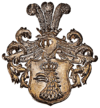
He impressed Kaiser William II, who ordered that Mackensen be given command from 17 June 1893 of the 1st Life Hussars Regiment (Leib-Husaren-Regiment Nr. 1), to which he became à la suite when he left its command on 27 January 1898, so he often wore the distinctive death's head uniform thereafter.[7] Mackensen was surprised by his next posting, as an adjutant to William II, because he was the first commoner to hold that position. For the next three and a half years he shadowed the Kaiser, meeting the high and mighty of Germany, the rest of Europe, and the Middle East. His sons shared gymnastics classes with the Kaiser's. He was ennobled on the Kaiser's 40th birthday, 27 January 1899, becoming August von Mackensen.[8] Next he received the command of the newly created Life Hussar Brigade (Leib-Husaren-Brigade) from 1901 to 1903, and from 1903 to 1908 commanded the 36th Division in Danzig.[9] He became a widower in 1905, and two years later married Leonie von der Osten, who was 22 years old. When Schlieffen retired in 1906, Mackensen was considered as a possible successor, but the job went to Helmuth von Moltke the Younger. In 1908 Mackensen was given command of the XVII Army Corps, headquartered in Danzig.[10] The Crown Prince was placed under his command, and the Kaiser asked Mackensen to keep an eye on the young man and to teach him to ride properly.[11]
First World War
Eastern Front

Already aged sixty-five at the outbreak of War in 1914, Mackensen's XVII Army Corps became part of the German Eighth Army in East Prussia, under General Maximilian von Prittwitz and 21 days later under General Paul von Hindenburg. Mackensen had his corps moving out on a twenty-five kilometer march to the Rominte River within fifty minutes of receiving his orders on the afternoon of 19 August 1914 when the Imperial Russian Army invaded East Prussia.[12] He led XVII Corps in the battles of Gumbinnen, Tannenberg and the First Battle of the Masurian Lakes, which drove the invading Russians out from most of East Prussia.
On 2 November 1914 Mackensen took over command of the Ninth Army from Hindenburg, who became Supreme Commander East (Oberbefehlshaber Ost). On 27 November 1914 Mackensen was awarded the Pour le Mérite, Prussia's highest military order, for successful battles around Łódź and Warsaw.
By April 1915 the Russians had conquered all of western Galicia, the Austro-Hungarian slice of partitioned Poland, and were pushing toward Hungary. In response to desperate pleas the German supreme commander Erich von Falkenhayn agreed to an offensive against the Russian flank by an Austro-German Army under a German commander. The reluctant Austro-Hungarian supreme command agreed that the tactful Mackensen was the best choice for commanding the coalition army. Army Group Mackensen (Heeresgruppe Mackensen) was established containing a new German Eleventh army, also under his command, and the Austro-Hungarian Fourth Army. As chief of staff he was assigned Hans von Seeckt, who described Mackensen as an amiable, "hands-on commander with the instincts of a hunter.” [13] His army group, which had an overwhelming advantage in artillery, smashed through the Russian lines between Gorlice and Tarnow and then continued eastward, never giving the Russians time to establish an effective defense, retaking most of eastern Galicia by recapturing Przemyśl and Lemberg[14] The joint operation was a great victory for the Central Powers, they had advanced 310 km (186 mi), and soon thereafter the Russians pulled out of all of Poland.
Mackensen was awarded oak leaves to his Pour le Mérite on 3 June 1915 and promoted to field marshal on 22 June. He also received the Order of the Black Eagle, Prussia's highest-ranking order of knighthood, as well as numerous honors from other German states and Germany's allies, including the Grand Cross of the Military Order of Max Joseph, the highest military honor of the Kingdom of Bavaria, on 4 June 1915.
Serbian campaign
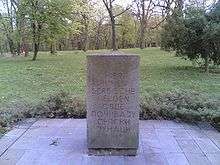
In October 1915, a new Army Group Mackensen (Heeresgruppe Mackensen, which included the German Eleventh Army, Austro-Hungarian Third Army, and Bulgarian First Army), launched a renewed campaign against Serbia. The campaign crushed effective military resistance in Serbia but failed to destroy the Serbian army, half of which managed to withdraw to Entente-held ports in Albania and, after recuperation and rearmament by the French and the Italians, reentered fighting on the Macedonian front. When Mackensen returned to Vienna he was honored by a dinner, a personal audience with the Emperor Franz Joseph and was decorated with the magnificently jeweled Military Service Cross 1, a unique award for a foreigner. [15]
During the fight for Belgrade in early October 1915, the troops of the Central Powers encountered very stiff resistance, in commemoration of which Mackensen erected a monument to the Serbian soldiers who died defending their capital, saying, -HIER RUHEN SERBISCHE HELDEN- - "Here rest Serbian heroes", both in German and Serbian. Mackensen is a figure in Serbian historiography and is greatly respected, the only enemy soldier and military leader to be so treated. He is always mentioned as a respected opponent by the Serbian soldiers and people. (see Dragutin Gavrilović)
Romanian campaign
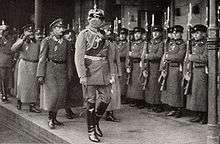
After Romania declared war on Austro-Hungary on 15 August 1916, Mackensen was given command of a multi-national army, with General Emil von Hell as chief of staff, of Bulgarians, Ottomans, Austro-Hungarians and Germans which assembled in northern Bulgaria and then advanced into southern Romania. By 8 September they had taken the two major forts on the right bank of the Danube, the first in a single day by a force that was outnumbered by the besieged, who were overwhelmed by Mackensen's artillery. [16] Then a German and Austro-Hungarian army group, commanded by Falkenhayn broke into northern Romania through the passes in the Transylvanian Alps, while Mackensen crossed the Danube by seizing bridgeheads on the left bank to shield the Austro-Hungarian engineers who built the long pontoon bridge. The Romanian army and their Russian allies were forced back between these pincers, Bucharest fell to Mackensen on 6 December, 1916, he rode in on a white horse and moved into the royal palace.[17]
For this performance, on 9 January 1917, Mackensen was awarded the Grand Cross of the Iron Cross, becoming one of only five recipients of this honor in the First World War. Since now he wore every Prussian medal, the kaiser decided to name a battlecruiser after him, which became the first in a new class. [18] Mackensen became the military governor of the large part of Romania (mainly Wallachia) occupied by the Central Powers. He proposed making a German prince king of Romania but the initiative fell through. His last campaign was an attempt to destroy the Romanian Army, which had been reorganized after the Kerensky Offensive. At Mărăşeşti both sides took heavy losses, but with the Romanian army emerging victorious (see Battle of Mărăşeşti). Mackensen maintained that he had never been defeated in battle, and surely was the most consistently successful senior general on either side in World War I. By December 1917, the Russian Army had collapsed and Romania was forced to sign the Armistice of Focșani, followed by the Bucharest Peace Treaty. Mackensen remained in Romania until the end of the war as military governor and de facto ruler. After the armistice he and the 200,000 men he was leading back home were rounded up in Hungary by General Louis Franchet d'Espèrey's Allied army and he was a prisoner until November 1919. His political thinking is revealed in his letters home in which he opposed a union of the Austrian part of the former empire with Germany because it would increase Catholic power in what should be a Protestant state, while he regarded the Jews as the core of detested Bolshevism [19] He was one of the 896 Germans on the Allied list of accused war criminals, which eventually was allowed to lapse.
Post-war career
In 1920, Mackensen retired from the army. Although standing in opposition to the newly established republican system, he avoided public campaigns. Around 1924 he changed his mind and began to use his image as war hero to support conservative monarchist groups. He routinely appeared in his old Life Hussars uniform and became very active in pro-military conservative organisations, particularly the Stahlhelm and the Schlieffen Society.
During the German presidential election of 1932, Mackensen supported Hindenburg against Hitler, but after Hitler gained power in 1933 Mackensen became a visible, if only symbolic, supporter of the Nazi regime.

One of his ceremonial visits brought him to Passau, where he received a hero's welcome.[20]
Mackensen's distinctive public profile, in his black Life Hussars uniform, was recognized by the Hausser-Elastolin company, which produced a 7-cm figure of him in its line of Elastolin composition soldiers.[21] Mackensen's fame and familiar uniform gave rise to two separate Third Reich units adopting black dress with Totenkopf badges: the Panzerwaffe, which claimed the tradition of the Imperial cavalry; and Hitler's "Life Guards," the SS.
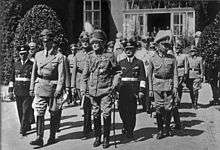
Although Mackensen appeared in his black uniform at public events organized by the German government or the Nazi Party, he objected to the killing of Generals Ferdinand von Bredow and Kurt von Schleicher during The Night of the Long Knives purge of July 1934, and to the atrocities committed during the fighting in Poland in September 1939. By the early 1940s, Hitler and Joseph Goebbels suspected Mackensen of disloyalty, but could do nothing.[22] Mackensen remained a committed monarchist and in 1941 appeared in full imperial uniform at Kaiser Wilhelm's funeral at Doorn, in the Netherlands.[23]
According to a radio news report dated 15 April 1945, filed by CBS News correspondent Larry LeSueur for World News Today, Mackensen was briefly captured by the British Second Army at his home during the closing weeks of the Second World War. Upon the arrival of the British, rather than making an expected war-like statement, the old soldier merely made the request that newly freed foreign workers should be "kept from stealing his chickens".[24]
Mackensen died on 8 November 1945 at the age of 95, his life having spanned the Kingdom of Prussia, the North German Confederation, the German Empire, the Weimar Republic, Nazi Germany, and the post-war Allied occupation of Germany.
Family
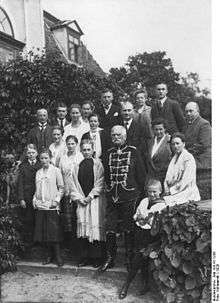
In November 1879, Mackensen married Dorothea von Horn (1854–1905), and they had five children:
- Else Mackensen (1881/2–1888)
- Hans Georg von Mackensen (1883–1947), diplomat
- Manfred von Mackensen
- Eberhard von Mackensen (1889–1969), Generaloberst and convicted war criminal
- Ruth von Mackensen (1897–1945)
In 1908, after the death of his first wife, Mackensen married Leonie von der Osten (1878–1963).
Citation
On 4 February 1940, Mackensen wrote to Field Marshal Walther von Brauchitsch: "As a man becomes older, he has to watch carefully that age has not reduced his creativity. After reaching the age of 90, I have decided not to involve myself any longer with matters that are not concerned with my private life. However, I am still the most senior German officer. Many turn to me, sometimes with wishes, but more often with their concerns. During these weeks our concern is with the spirit of our unique and successful Army. The concern results from the crimes committed in Poland, looting and murder that take place before the eyes of our troops, who appear unable to put an end to them. An apparent indifference has serious consequences for the morale of our soldiers and it is damaging to the esteem of our Army and our whole nation. I am sure that you are aware of these events and that you certainly condemn them. These lines intend to convey my daily growing concern at the reports that constantly reach me, and I have to ask you to take up this matter with the highest authority. The messages I receive are so numerous, many come from high ranking persons and from witnesses. As the most senior officer I cannot keep them to myself. In transmitting them to you, I fulfil my duty to the Army. The honour of the Army and the esteem in which it is held must not be jeopardised by the actions of hired subhumans and criminals. Sieg heil."[25]
Honours
- Pour le Mérite with Oak Leaves
- Pour le Mérite (27 November 1914) - for his work on the Russian front
- Oak Leaves (14 June 1915)
- Grand Cross of the Military Order of Max Joseph (4 June 1915)
- Grand Commander of the Royal House Order of Hohenzollern (1915)
- Order of the Black Eagle (August 1915)
- Grand Cross of the Order of Saint Stephen of Hungary (September 1915)
- Military Merit Cross, 1st class with Diamonds (Austria-Hungary, 6 December 1915)
- Commander, First Class of the Military Order of St. Henry (6 December 1915)
- Grand Cross of the Iron Cross (9 January 1917)
- Grand Cross of the Order of St. Alexander with Diamonds (Bulgaria)
- Grand Cross of the Military Order of Maria Theresa
The University of Halle-Wittenberg appointed him to Honorary Doctor of Political Sciences and the Gdańsk University of Technology granted him the title Doktor-Ingenieur.
Mackensen-class battlecruiser, named after Mackensen, was the last class of battlecruisers to be built by Germany in the First World War, the lead ship, SMS Mackensen, was launched on 21 April 1917.
Mackensen was an Honorary Citizen of many cities, such as Danzig, Heilsberg, Buetow, and Tarnovo. In 1915, the newly built rural village of Mackensen in Pomerania was named after him. In various cities, streets were named after him. In 1998 the Mackensenstrasse in the Schöneberg district of Berlin was renamed Else Lasker-Schüler-road, based on an erroneous claim that Mackensen was one of the "pioneers of National Socialism".[26]
Notes
- ↑ David T. Zabecki, Germany at War: 400 Years of Military History, p. 808
- ↑ Some historians refer to him as "Anton Mackensen", but this is unusual. See Lamar Cecil, "The Creation of Nobles in Prussia, 1871-1918" in The American Historical Review, Vol. 75, No. 3. (February, 1970), pp. 794; Gerard E. Silberstein, "The Serbian Campaign of 1915: Its Diplomatic Background" in The American Historical Review, Vol. 73, No. 1. (October 1967), 60.
- ↑ Theo Schwarzmüller, Zwischen Kaiser und "Führer". Generalfeldmarschall August von Mackensen. Eine politische biographie. (Munich: Deutsche Taschenbuch Verlag, 1995), 17–29.
- ↑ Schwartzmüller, Theo (1997). Zwischen Kaiser und "Führer". Generalfeldmarschall August von Mackensen. Paderborn: Ferdinand Schöningh. p. 34.
- ↑ Schwarzmüller, 1997, p. 49.
- ↑ Schwarzmüller, 1997, p.65.
- ↑ Günter Wegner, Stellenbesetzung der deutschen Heere 1815-1939 (Biblio Verlag, Osnabrück, 1993), vol. 3, pp. 97–98.
- ↑ Schwarzmüller, 1997, p.6 5.
- ↑ Wegner, 1993, p. 131 and p. 463.
- ↑ Wegner, 1993, p. 80.
- ↑ Jonas, Klaus W (1961). The life of Crown Prince William. London: Routledge and Kegan. p. 70.
- ↑ Showalter, Denis. E. (1991). Tannenberg: clash of empires. Hamden, CT: Archon. p. 178.
- ↑ Schwarzmüller, 1997, p. 105.
- ↑ DiNardo, Robert L. (2010). The Gorlice-Tarnow campaign, 1915. Praeger.
- ↑ Schwartzmüller, 1997, pp. 124-125.
- ↑ Stone, Norman (1998) [1971]. The Eastern Front 1914-1917. London: Penguin. pp. 277–281.
- ↑ Gilbert, Martin (1994). The First World War: A Complete History. New York: Henry Holt and Company. p. 302. ISBN 080501540X.
- ↑ G. Müller, The Kaiser and his court, London, Macdonald, 1951 p. 222
- ↑ Schwartzmüller, 1997, p. 170 and p. 178.
- ↑ Anna Rosmus Hitlers Nibelungen, Samples Grafenau 2015, pp. 111f.
- ↑ (Figure #651/1)[See: Hausser Elastolin Spielzeug 1939-40 (toy catalog)]
- ↑ Norman J. W. Goda, "Black Marks: Hitler's Bribery of His Senior Officers during World War II", in The Journal of Modern History, Vol. 72, No. 2. (June, 2000), 430–432.
- ↑ Anna Rosmus Hitlers Nibelungen, Samples Grafenau 2015, pp. 112f.
- ↑ 1945 Radio News, "1945-04-15 CBS World News Today" at around 14:25, at archive.org.
- ↑ Field Marshal von Manstein, a Portrait (The Janus Head - Marcel Stein)
- ↑ luise-berlin.de
References
- Cecil, Lamar. "The Creation of Nobles in Prussia, 1871-1918." In The American Historical Review, Vol. 75, No. 3. (Feb., 1970), pp. 757–795.
- Foley, Robert. German Strategy and the Path to Verdun. Cambridge University Press, 2004.
- Goda, Norman J. W. "Black Marks: Hitler's Bribery of His Senior Officers during World War II." In The Journal of Modern History, Vol. 72, No. 2. (June, 2000), 413-452.
- Hedin, Sven. Große Männer denen ich begegnete, Zweiter Band, Wiesbaden, F.A. Brockhausen, 1953.
- Mombauer, Annika. Helmuth von Moltke and the Origins of the First World War. Cambridge University Press, 2001.
- Schwarzmüller, Theo. Zwischen Kaiser und "Führer." Generalfeldmarschall August von Mackensen. Eine politische Biographie. Munich: Deutscher Taschenbuch Verlag, 1995.
- Silberstein, Gerard E. "The Serbian Campaign of 1915: Its Diplomatic Background." In The American Historical Review, Vol. 73, No. 1. (October 1967), pp. 51–69.
- Hausser Elastolin Spielzeug 1939-40' (toy catalog)
- Die Deutsche Wochenschau 16 December 1944 Danish language version. 2:42 min: celebration of 95th birthday of August von Mackensen on December 6, 1944.
External links
-
 "Mackensen, August von". Encyclopædia Britannica (12th ed.). 1922.
"Mackensen, August von". Encyclopædia Britannica (12th ed.). 1922.
| Military offices | ||
|---|---|---|
| Preceded by General der Infanterie Georg von Braunschweig |
Commander, XVII Corps 27 January 1908 – 1 November 1914 |
Succeeded by General der Infanterie Günther von Pannewitz |
| Preceded by Generaloberst Paul von Hindenburg |
Commander, 9th Army 2 November 1914 – 17 April 1915 |
Succeeded by General der Kavallerie Prince Leopold of Bavaria |
| Preceded by General der Infanterie Max von Fabeck |
Commander, 11th Army 16 April 1915 – 8 September 1915 |
Succeeded by General der Artillerie Max von Gallwitz |
| Preceded by New Formation |
Commander, Army Group Mackensen (Poland) 22 April 1915 - 8 September 1915 |
Succeeded by Dissolved |
| Preceded by New Formation |
Commander, Army Group Mackensen (Serbia) 9 September 1915 - 30 July 1916 |
Succeeded by Otto von Below |
| Preceded by New Formation |
Commander, Army Group Mackensen (Romania) 28 August 1916 - 7 May 1918 |
Succeeded by Dissolved |
| Wikimedia Commons has media related to August von Mackensen. |